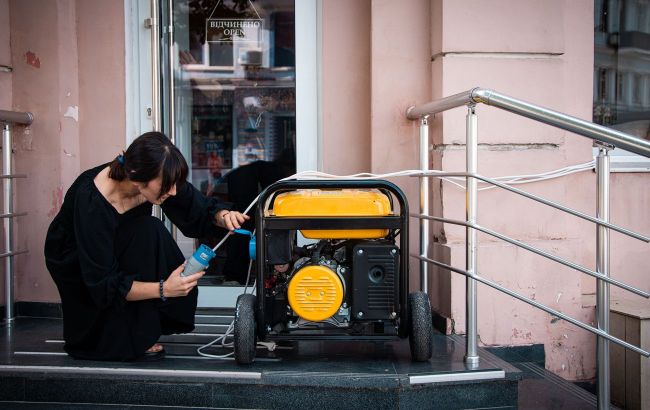Kyiv preparing for long power outages: Costs and efforts
 Photo: Preparing for possible long-term power outages (Getty Images)
Photo: Preparing for possible long-term power outages (Getty Images)
The chronic energy crisis over Russian shelling could worsen to a larger extent in the winter. Read more about how Kyiv's urban infrastructure, residential buildings, restaurants, and retail chains are preparing for possible challenges in RBC-Ukraine's article.
Contents
- How hospitals, schools, and homes are preparing
- How much it will cost to install equipment at home
- Solar station on credit. What co-financing programs are available
- Three times more expensive with generators. What is the situation in hypermarkets
- Narrowing the menu and rising prices. Impact of blackouts on restaurants
In the summer, power outages continue in Ukraine due to Russian strikes on the energy infrastructure. Although a total blackout is not expected, the situation is still difficult.
Businesses in Kyiv have adapted quite quickly: numerous generators make noise on the streets near cafes and shops, literally next to each other during rolling blackouts. The situation is worse in residential buildings. To keep the elevators and lighting working at home and in the stairwell, people have to take care of it themselves: buy powerful equipment that costs hundreds of thousands, and sometimes millions of hryvnias. Residents are not always ready to raise money for this.
How hospitals, schools, and homes are preparing
This spring, the enemy has been mercilessly shelling the Ukrainian energy system, and Kyiv (like the rest of Ukraine) has to live in conditions of rolling blackouts. Power companies are trying to reduce the periods of blackouts, but the shortage of electricity production means the schedules are still in effect.
The blackouts apply to all buildings and facilities in the city, except for critical infrastructure or those connected to the same source as critical infrastructure, Petro Panteleev, deputy head of the Kyiv City State Administration, tells RBC-Ukraine.
"Facilities where the electricity is vital, such as hospitals with inpatient departments, must not be cut off. Also, all hospitals in the capital are equipped with generators, which the city began installing 5-6 years ago," he adds.
Kyiv also has more than two dozen mobile boiler houses, which can provide heat to such institutions in the winter in case of an emergency. Such a boiler house can operate without refueling for up to 6 days. Pressure and temperature can also be controlled remotely. The city also introduced a special street lighting regime to reduce consumption.
However, it is difficult for residential buildings to function fully during outages, the Kyiv City State Administration says. There are difficulties with pumping equipment for pumping and normal water supply, and the operation of elevator equipment, especially in high-rise buildings.

Photo: Mobile boiler houses in Kyiv (kyivcity.gov.ua)
We live in a reality where the country and the city are responsible for part of the preparation for blackouts, and at a second level, residents of apartment buildings should prepare together. And it is up to the apartment owners to take care of the apartment, Maksym Petrenko, chairman of the Kyiv Association of Condominiums and Housing Cooperatives, tells RBC-Ukraine.
There are loans and co-financing, but the bulk of the organization and costs are borne by the residents themselves.
In the building, it is necessary to ensure the operation of engineering systems to supply heat and cold water to the apartment. These are individual heating stations, pumping stations, roof or attached gas boilers, intercom systems, video surveillance, etc. Ideally, all this should be organized in advance. For example, during long outages, the city will provide cold water pressure that will lift the water no higher than the 10th floor.
As for what is the responsibility of the buildings (condominiums, management companies, cooperatives), only 10-15% are well prepared for possible blackouts, Petrenko believes. In his opinion, even according to optimistic estimates, about 300-400 houses are ready: "Compared to all the housing in the city," he says, "it's like a drop in the bucket."
How much it will cost to install equipment at home
It is expensive to provide such equipment for housing infrastructure. Maksym Petrenko gives an example: a reliable 28-kilowatt generator for a house can cost up to 400,000 hryvnias ($10,000). Another 100,000 ($2,500) will be spent on connection.
Besides, it is advisable to prepare project documentation and take into account fixed maintenance costs: the total cost of a kilowatt-hour produced by a generator will be approximately 35-45 hryvnias ($1).
A project to install batteries and inverters to power heating and water supply systems, as well as elevators, will cost about 1 million hryvnias ($25,000). In Kyiv, several condominiums have installed solar stations. This is not yet a mass trend, but there are more and more examples.
"We are working on amendments to the laws to be able to sell the surplus electricity generated by the solar station and share it with others. If this is implemented, condominiums will also be able to earn money - they will be paid at the green tariff at prices for 2024 - UAH 5.15 ($0.12) per kilowatt," says Petrenko.
Now the head of the union is trying to purchase uninterruptible power supply equipment that will provide cold water not only to his house but also to the neighboring ones. To do this, he needs to talk to the neighbors.

Photo: Residents need to prepare for blackouts mostly at their own expense (Getty Images)
"We come across some difficult residents. They still think that someone should come to them and give them everything. It is difficult to convince them that it is their property for which they are responsible. And they are the ones who determine how to maintain and control it, how much to pay for it," the source notes.
Most of the heads of condominium boards want to install all possible additional devices to keep the houses lit during power outages. But they see the reluctance of residents to contribute money, confirms the head of one of the cooperatives in a residential area of Kyiv. To apply for any of the programs, you need to have at least half a million hryvnias on your account, he tells RBC-Ukraine.
"Where to get the money if people are not ready to give it? Every day I 'fight' with some residents to ensure that they at least pay their utility bills on time. People are very different. Some people have left but pay their utility bills conscientiously from Germany. And there are apartments with debts of 80 thousand hryvnias. It is simply unrealistic to persuade them to raise money for a generator or something like that," admits the head of the cooperative.
Preparing an ordinary apartment for blackouts is not cheap either. Of course, you can get by with candles and USB lamps, but powering up the sockets is a significant expense.
Maksym Petrenko installed an inverter and a battery in his apartment. Thanks to this, he always has light during power outages: all the light bulbs are on, and all the sockets are working, providing power to various household devices. This system cost him 2 thousand dollars. The apartment is equipped with everything he needs: a router, refrigerator, iron, and microwave.
Solar station on credit. What co-financing programs are available
Following a June 20 meeting of the Supreme Commander-in-Chief's Staff on energy, tasks were set to prepare for the winter season. The plan is to launch a program to stimulate solar generation and energy storage - similar to the 5-7-9 program, but at 0% for citizens.
At the same time, there are already one state and several municipal programs that compensate for the costs of alternative energy, Petrenko says.
For example, the state program Green House provides grants to offset the cost of solar panels, inverters, and batteries. However, the program can be used only if there are sufficient funds in the account of the condominium and the general meeting has made a decision.
"This project, even if we are in a hurry, will be implemented only in September-October, when there will be almost no solar electricity: we will see the results next year," explains the head of the association.
Kyiv has three municipal programs that allow residents to install alternative power sources or various energy-efficient equipment in their homes. The city reimburses at least 70% of the cost. And these programs are valid both for condominiums and housing cooperatives and for houses where they are not created, says Petro Panteleev.

Photo: The Khudozhnyk condominium on Velyka Vasylkivska Street in Kyiv has installed a solar station on its building (kyivcity.gov.ua)
"Nowadays, there is a lot of attention to the Procedure for partial reimbursement of the cost of independent energy sources: gasoline, diesel, gas generators, solar charging stations, inverters, etc. This has become a kind of salvation for hundreds of homes after the enemy began massive shelling of energy facilities," says the deputy head of the Kyiv City State Administration.
The mechanism allows to compensate 75% of the cost of a generator or other equipment already purchased. As of the beginning of this year, more than 670 units of various equipment have been installed in residential buildings in Kyiv, and the amount of compensation amounted to about UAH 18.6 million, according to the KCSA.
There are about 12 thousand residential buildings in Kyiv of different series, years of construction, and technical conditions. They require different capacities and amounts of equipment, and different amounts of assistance. The municipality is currently formulating proposals for changes and will then submit them to the Kyiv City Council for consideration and approval.
Kyiv also has a 70/30% energy efficiency project competition. Only condominiums and housing cooperatives can participate in it. The city pays 70% of the cost of installing, for example, individual heating points, house meters, facade or roof insulation, and replacement of windows and doors in corridors to save heat, electricity, and residents' money.
More than 700 such projects have already been implemented. These are hundreds of millions of hryvnias in savings, the KCSA says.
The third program is Overhaul. It is open to everyone, including houses without condominiums or housing cooperatives. There is a longer list of works for which compensation can be received and different options for financial correlation.
"For example, replacing an elevator is a very expensive project, and people would be stopped by the large amount of money they would have to invest as part of their co-financing. That's why the ratio is 95/5%. So, you have a new elevator for 5% of its cost. But an important element is bringing people together and making a common decision. The program also includes energy-efficient works, where the ratio has not changed - 70/30%," says Panteleev.
One needs to correctly calculate the technical part and take into account inflationary risks to participate in all programs and avoid getting a debt, advises Maksym Petrenko. It is important to talk to all residents about how to implement everything in practice.

Photo: Installing solar stations on houses is not yet a mass phenomenon, but there are more and more examples (Getty Images)
"I expect that at first we will spend UAH 300,000, and further expenses will reach several million in the future. But we will definitely protect ourselves from power going out for a long time. The stairs and landings on all floors will be illuminated, and intercoms will work. And the apartments will have heating and cold water even in a blackout," says the head of the association.
Three times more expensive with generators. What is the situation in hypermarkets
Shopping malls and large stores have become Points of Invincibility since the previous blackouts. Since the fall of 2022, people have been flocking to stores of various chains to recharge their phones. In the summer, such points are not removed, because the blackouts continue to this day.
In fact, all major retail chains have installed additional power supplies. In Auchan, Silpo, Leroy Merlin, and other chains, you can now see signs like "Here you can recharge your gadgets and use the Internet."
All Epicenter shopping centers have diesel generators: they automatically turn on when the centralized power supply is cut off, the company's press service tells RBC-Ukraine. In previous years, after massive attacks on the infrastructure, Epicenter diagnosed, repaired, and sometimes replaced, this equipment to ensure that they could sustain the blackout.
The chain promises to continue working without electricity, even though power supply with diesel generators costs three times more on average. They will also continue the national project Sharing the Light - all the shopping centers of the chain have charging stations for gadgets called Chargers.
Six solar power plants with a total capacity of 6.8 MW were installed on the roofs of the shopping centers. This allows replacing up to 30% of electricity consumption. In 2024-2025, the company plans to equip 16 more shopping centers and a logistics center with solar panels, increasing the total capacity of its own solar power plants by another 25 MW. They also plan to install ground-based solar power plants.
All Eco Market stores are equipped with generators for autonomous operation. They have been preparing for blackouts since the first shelling of energy infrastructure in 2022, the company told RBC-Ukraine.
_1.jpg)
Photo: Almost all shops and food chains have already installed generators (Getty Images)
Of the 90 markets, half are located in the regions. Some stores have installed more powerful generators to meet the needs of not only the store itself but also tenants and mobile communication stations, says Denys Pohorelov, Eco Market's Deputy CEO for Retail Network Management.
The chain has upgraded its equipment to more energy-efficient ones: refrigeration equipment has been installed that works more efficiently during blackouts and reduces the load on the power grid during hours with power supply. To provide heat, there are modular heating systems - autonomous heat pumps.
"This allows us to maintain a comfortable temperature in cold weather, provided that there is enough electricity from generators or the grid to run them," says a company representative.
All of the company's stores have areas for charging gadgets for the winter. They are also planning to create separate heating areas if the heating situation is difficult in winter. People will be able to come and charge their devices. Provided that this does not affect the total load.
"There were cases when people brought electric kettles and it overloaded the system. In such situations, we urge people to contact our employees - they will help guests, in particular with hot water. Also, during blackouts, there will be an opportunity to buy ready-to-eat and hot food in the markets with cooking," says Pohorelov.
Narrowing the menu and rising prices. Impact of blackouts on restaurants
For cafes and restaurants in Kyiv, generators or other means of power have been a must-have since the first blackouts. However, many small coffee shops are often closed during blackouts, the owner of a small cafe in Podil tells RBC-Ukraine.
"If the place is not very busy, it is difficult to sell 10 servings of coffee. Most people pass by us to go to the bus stop. There seem to be a lot of people, but most of them are in a hurry and don't stay. So if the blackouts are long, I don't see any point in keeping the place open from morning to evening," the source says.
But there have been power outages before, and Kyiv restaurateurs are well prepared. They bought generators and charging stations. Therefore, it is rather rare to see a large and posh place in the city without additional energy sources.

Photo: Restaurants and cafes are becoming Points of Invincibility, but incur additional costs (Getty Images)
Most restaurants are ready even for long blackouts, Yevhen Komarov, a business developer, lawyer at Global Law, and chairman of the legal committee of the Ukrainian Restaurant Association, tells RBC-Ukraine.
"I believe that those who decide to close during blackouts are doing the right thing. It is indeed sometimes cheaper to close the doors and open them when there is full-fledged work. If you look at the cash registers in a restaurant, every hour without electricity is about 10% of the total revenue," the expert says.
"Restaurants are becoming a kind of Point of Invincibility where people go when there is no electricity at home. But still, they incur additional costs for satellite Internet, cable installation, and powerful generators, and this needs to be monetized somehow. Depending on the capacity of the generator, sometimes you often have to choose one thing: deep fryer, oven, or refrigerator.
Another trend in restaurants is the use of semi-finished dishes. Someone has transferred part of the capacity from the place to production elsewhere. Some buy semi-finished or ready-made meals. Others work purely on delivery.
The average check in restaurants will grow, Komarov predicts. Restaurants are also dependent on suppliers. Delivery of goods is complicated, and the price increase is due to additional costs for generators. If suppliers have a lot of products, the refrigerators pull much more energy. And, accordingly, a lot of money.
The war in Ukraine has also disrupted logistics. There are regions where goods do not reach, or from which it is no longer possible to deliver anything. Due to the mobilization, many forwarders and drivers are mobilized during their work. Sometimes there is basically no one to deliver the goods. Komarov predicts that prices may rise even without blackouts. After all, electricity tariffs have increased.
"On the other hand, due to the optimization of processes, we may see a narrowing of the menu, we will see fewer options there," Komarov points out.

Photo: Every hour without power for restaurants is about 10% of total revenue (Getty Images)
In the summer season, he says, places that go to various themed festivals can benefit. If everything is organized properly, one can earn more money at such events than in a restaurant. Thanks to the large number of guests, it can be a success, and sales will grow.
It is now obvious that the main costs of all additional means of electricity are borne by the people themselves - apartment residents and business owners. And expensive equipment will only grow in price with increased demand.
Fortunately, almost all hospitals and other important infrastructure in Kyiv can operate without electricity for some time. If necessary, the already-known Points of Invincibility will be quickly opened. But if the enemy's missile attacks on infrastructure continue, the issue of electricity supply will become even more acute. And Ukrainians need to become energy independent at their own expense, and now.

